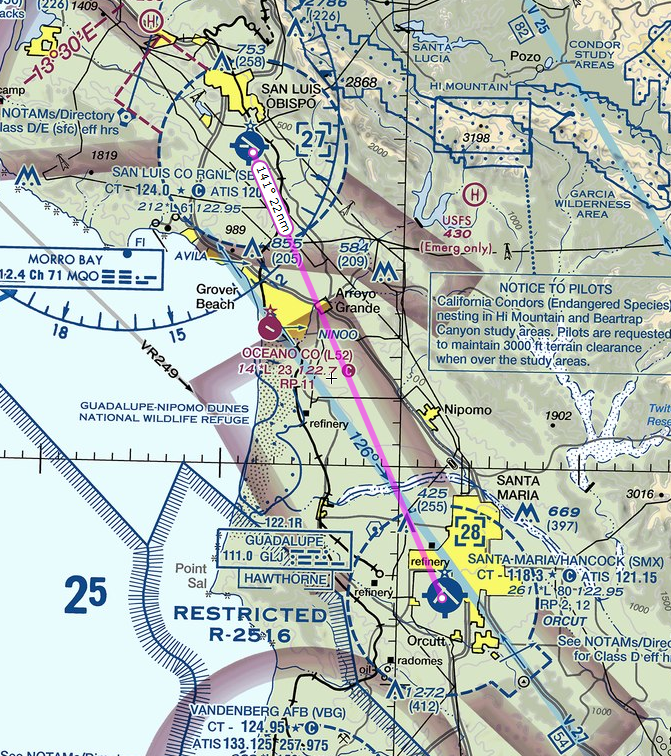CAT-04 Flight: Class D to Class D
Description
Conduct a flight from San Luis County Regional Airport (KSBP) to Santa Maria Airport (KSMX) without any en-route air traffic control services.

Learning Objectives
- Become familiar with radio communications when departing a Class D airport.
- Review radio communications when arriving at a Class D airport.
- Review basic VFR navigation skills.
Flying the Rating
To successfully complete this rating you must accomplish the following tasks:
- Fly from KSBP to KSMX without any en-route ATC services.
- Inform ATC on initial contact at KSBP that you are performing the CAT-4 Rating.
- Meet the CAT Ratings Practical Test Standards
Airspace Review
Both KSBP and KSMX are located in Class D airspace. Prior to operating in Class D airspace you must have two way radio communications with ATC. This consists of calling ATC and having them reply with your callsign.
En-route you will generally be operating in Class E airspace. There are generally no requirements to operate in Class E airspace.
Communications Review
When departing a Class D airport you will start by contacting ground with your location, direction of departure (South), and the ATIS code. Ground will issue taxi instructions and you’ll taxi to the runway in use.
The tower will issue either specific departure instructions or a general on course clearance with your departure clearance. For a South departure the tower could instruct you to do a left downwind departure, right downwind departure, or simply tell you “South Departure Approved.”
If the tower specifies a specific pattern leg to depart on simply fly the pattern as normal to that point and then fly away from the airport on that leg. If the tower did not specify a pattern leg to depart on you may depart however you like.
Once clear of the Class D airspace it is NOT necessary to ask the tower for a frequency change. You may simply tune to another frequency as soon as you clear the airspace.
Transcript
VFR Arrivals into a Class D airport have been covered in other ratings. Below is an example of radio transmissions for a VFR departure from a Class D airport.
N123AB: “San Luis Ground, Cessna 123AB, transient parking, south departure, taxi with echo.”
San Luis Ground: “Cessna 123AB, San Luis Ground, runway 29 taxi via alpha.”
N123AB: “Runway 29 taxi via alpha, Cessna 123AB.”
When ready for departure:
N123AB: “San Luis Tower, Cessna 123AB, holding short runway 29.”
San Luis Tower: “Cessna 123AB, San Luis Tower, make left downwind departure, runway 29, cleared for takeoff.”
N123AB: “Cleared for takeoff runway 29, left downwind departure, Cessna 123AB.”
When clear of the KSBP Class D airspace you can switch off of tower frequency. En-Route Monitor 121.5.
Cockpit Video
Related Material
VFR Communications Manual (commercial product) provides detailed guidance on ATC communications for VFR flights.
Airport Traffic Patterns (Wikipedia)
Web site containing scrollable, zoomable VFR and IFR charts
VFR Cruising AltitudesPilot’s Handbook of Aeronautical Knowledge – Navigation
VFR Flight Planning and Navigation Workshop
YouTube recording of a live workshop conducted by PilotEdge covering VFR flight planning and navigation methods.






